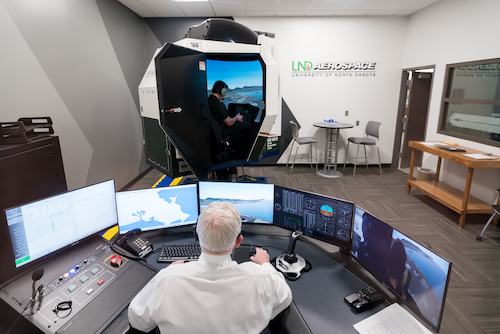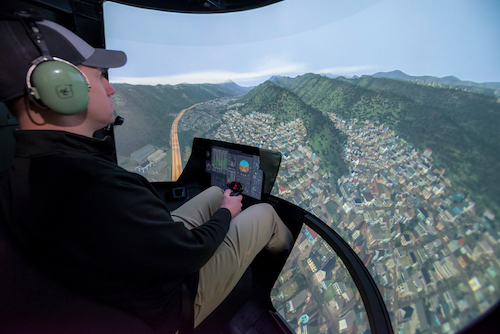|
Oct
02
2023
|
|
Posted 2 years 102 days ago ago by Admin
|
|

VIEW VIDEO
Every year there are reports of fatal accidents where the pilot became spatially disoriented and crashed due to flying into inadvertent instrument meteorological conditions. According to the US Helicopter Safety Team, since the year 2000, there have been over 130 fatal accidents due to flying into visually degraded environments. These incidents occur regardless of pilot experience and are often the result of insufficient planning, decision-making, and inadequate training for the unexpected.
On 26 January 2020, an experienced helicopter pilot crashed into the mountains of Southern California. This tragedy claimed the lives of nine people, including Kobe Bryant and his daughter. The National Transportation Safety Board found that pilot error was the primary cause of the crash. The pilot flew into low-level clouds, became spatially disoriented, and collided with a nearby hillside while attempting to navigate in a visually degraded environment, despite having over 8,000 flight hours, including more than 1,000 hours in the Sikorsky S-76. This pilot also served as a company check airman and chief pilot for the company. Even the most experienced and qualified pilots are not immune to the dangers of spatial disorientation. The helicopter industry and the University of North Dakota (UND) are searching for solutions that could help prevent tragedies like this.
UND is renowned for its world-class flight training program. With North America’s largest collegiate aviation program, UND's John D. Odegard School of Aerospace Sciences sets the bar for professional aerospace education. With over 500 faculty and staff and more than 1,800 students from all corners of the world, UND is the leading provider of collegiate helicopter flight training with more than 40 years of experience. Throughout its history, UND Aerospace has trained helicopter pilots for organizations such as the U.S. Army, U.S. Customs and Border Protection, foreign governments, and private corporations in addition to undergraduate students. The University of North Dakota maintains a fleet of over 100 aircraft and flight simulators, including five Robinson R44 Cadet helicopters, each featuring a Garmin avionics suite with touch-screen interface, bird strike-resistant windscreens, and innovative flight data monitoring equipment. In addition, the university boasts a cutting-edge maintenance facility and provides a comprehensive academic curriculum, beginning with bachelor’s degrees and continuing through graduate and Ph.D. programs. These programs equip graduates with the necessary knowledge and expertise to be successful in various segments of the aviation industry.
Environmental Tectonics Corp.
Environmental Tectonics Corporation (ETC) Aircrew Training, located in Southampton, Pennsylvania, is renowned for its expertise in aviation aeromedical training. ETC has provided the most realistic, versatile, and cost-effective flight training devices for five decades, and specializes in maintaining the most cutting-edge aerospace physiology training equipment. One of ETC’s latest commercial products is the GAT-Helo, and this new simulator changes the way the helicopter industry trains pilots. ETC and UND have teamed up to develop and introduce this training to the civilian helicopter industry. Before the GAT-Helo, this training was only available at the U.S. Army helicopter training headquarters in Fort Novosel (previously named Ft. Rucker), Alabama. This innovative training tool offers a highly realistic experience with pitch, roll, and 360° of yaw combined with beautiful and realistic full-dome visuals. The full-motion features of the GAT-Helo provide pilots with a controlled environment to simulate and prepare for various illusions and scenarios. By utilizing the GAT-Helo, pilots can improve their skills and enhance their preparedness for real-world situations, surpassing the limitations of traditional training methods. The GAT-Helo is a cutting-edge helicopter simulator that offers a unique training experience for pilots. It is the only one of its kind that provides a safe and realistic training environment for pilots to learn how to overcome spatial disorientation and recover from unexpected scenarios. With the ability to control every aspect of the flight, the instructor can provide a customized training experience that suits the pilot's needs. By training on the GAT-Helo, pilots can sharpen their skills and become better equipped to handle illusions they face in the real world. UND’s commitment to providing world-class training, paired with the GAT-Helo, makes it a destination of choice for all pilots.

At UND, incoming pilots will receive a comprehensive briefing on the features and capabilities of the GAT-Helo simulator as well as a refresher on the physiology of human orientation, spatial disorientation, and visual interpretation in flight. Designed specifically to address the unique challenges helicopter pilots face, the simulator offers training in areas such as spatial disorientation, IIMC recovery, unusual attitudes, instrument and navigation, and basic flight procedures. With its cutting-edge design and full-motion features, the GAT-Helo allows pilots to experience a wide range of illusions and scenarios in a safe and controlled environment. From the Coriolis Illusion to Flicker Vertigo, pilots will undergo multiple training profiles designed to help them recognize and recover from these conditions, minimizing the risk of accidents caused by spatial disorientation. Through hands-on training and interaction with experienced instructors, the university is taking a major step forward in its mission to provide the highest quality training and support to current and next generation helicopter pilots.
When a pilot begins their training in the GAT-Helo, the instructor will initiate a free flight scenario at the airport. This allows the pilot to familiarize themselves with the controls and feel comfortable operating the simulator. The simulator is not aircraft specific, reducing the need for complex procedure and system knowledge. When the pilot feels comfortable with the controls and instruments, the instructor will guide the pilot through basic VFR maneuvers.
Upon completion of the basic spatial disorientation scenarios, the pilot will be tasked with more complex scenarios such as navigating the helicopter to an off-airport landing zone, where they may encounter conditions such as brownout, whiteout, or, if desired, the instructor may induce a scenario that requires the pilot to maintain a hover over a floating life raft or approach an offshore oil rig. Throughout the training, the instructor can simulate instrument failures, unusual attitudes, or bring about adverse weather conditions to provide the pilot with experience in Inadvertent Instrument Meteorological Conditions (IIMC). The training can be conducted in simulated daylight or nighttime conditions, and for pilots and operators who utilize night vision goggles (NVGs), the GAT-Helo can be configured to provide a realistic NVG flight environment. Pilots can even bring their own equipment and NVGs they usually fly with into this simulator for full immersion.
The training is conducted in a computer-generated 3D flight area database that includes the continental USA and the Hawaiian Islands. The airports featured in the simulation have realistic runway and taxiway markings, runway lights, approach lighting systems, and glide slope indicators, providing the pilot with a highly realistic flight experience. The terrain and surface features can even be customized to meet the trainee’s needs.

History has taught us that traditional helicopter training methods have not properly equipped pilots for inadvertent flight into visually degraded environments. The University of North Dakota along with ETC have taken aim at those methods to create a safer industry for all pilots. With the university’s training experience, the GAT-Helo provides a valuable tool to expose pilots to identify and recover from potentially fatal illusions in a controlled environment. The objective is to equip pilots with the necessary knowledge and skills to respond appropriately to real-life scenarios. UND Aerospace is now offering corporate classes to the helicopter industry at UND’s world-class training center in Grand Forks, North Dakota. The technology of the GAT-Helo, paired with the expertise that UND provides, will undoubtedly save lives.
VIEW VIDEO
READ MORE ROTOR PRO: https://justhelicopters.com/Magazine
WATCH ROTOR PRO YOUTUBE CHANNEL: https://buff.ly/3Md0T3y
You can also find us on
Instagram - https://www.instagram.com/rotorpro1
Facebook - https://www.facebook.com/rotorpro1
Twitter - https://twitter.com/justhelicopters
LinkedIn - https://www.linkedin.com/company/rotorpro1